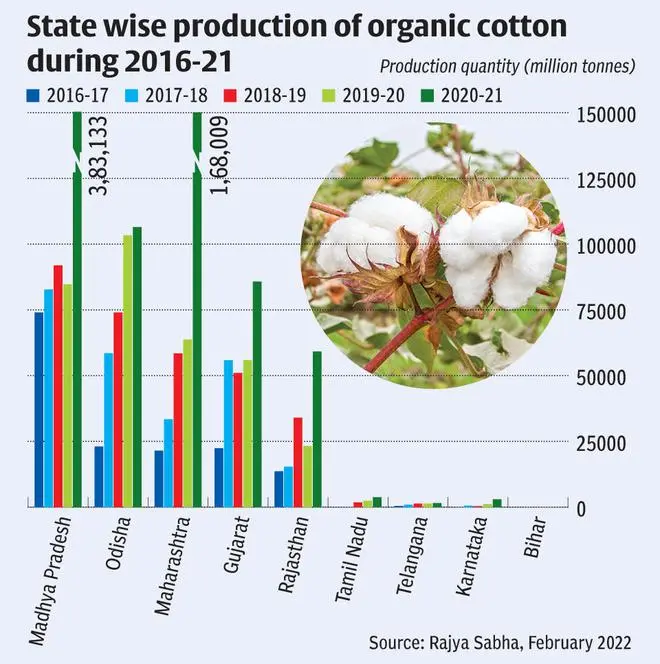India’s cotton production of over 360 lakh bales (about 6.12 million tonnes) accounts for around 25 per cent of the global output of the fibre .
The production of organic cotton in India is 1.23 million tonnes (mt), which is 51 per cent of global organic cotton production of 2.40 mt. The other organic cotton-producing countries are China, Kyrgyzstan, Turkey, Tajikistan, Tanzania, USA, Uganda, Greece, Benin, Peru, Burkina Faso, Pakistan, Egypt, Ethiopia, Brazil, Mali, and Argentina.
However, organic cotton production is limited to few States owing to the high production cost, lower demand and farmers turning to illegal GM seeds.

Production up
In the last five years, the organic cotton production has seen a rise even with the proliferation of illegal herbicide-tolerant Bt (HTBt) cotton seeds in Maharashtra, Andhra Pradesh, Telangana and other States. But organic cotton production is concentrated in Madhya Pradesh, Maharashtra, Gujarat, Odisha, and Rajasthan. Together, these States have produced 18,61,926 tonnes of organic cotton, which is 99 per cent of the total cotton production in India in the last five years.
According to the Ministry of Textiles data, presented to Rajya Sabha last month, the production of organic cotton during 2020-21 has been 8,10,934 tonnes against 3,35,712 tonnes during 2019-20 and 3,12,876 tonnes during 2018-19.
Madhya Pradesh tops the organic cotton producers chart with 38 per cent of the total production during the last five years followed by Odisha (20 per cent) and Maharashtra (19 per cent). Gujarat ( 15 per cent) and Rajasthan ( eight per cent) are the other two major organic cotton producers.
Interestingly, the Department of Agriculture and Farmers Welfare is implementing a cotton development programme under National Food Security Mission (NFSM) in 15 major cotton-growing States to enhance production and productivity. But as per the government data, only eight States have produced organic cotton in the last five years.
Organic cotton farming
The Indian Council of Agricultural Research (ICAR)-Central Institute for Cotton Research (CICR) and All India Coordinated Research Project (AICRP) on cotton have released 64 non-Bt (non-GM) cotton varieties/hybrids during 2017-21 that can be adopted by organic cotton growers. More than 6.5 million cotton farmers are directly engaged in cultivation and around 10.5 million workers in the allied sectors. India is also the No 2 consumer globally with an estimated consumption of 303 lakh bales (of 170 kg each).
“ It will take time to shift a major portion of cotton cultivation to organic cotton . But farmers are definitely considering organic as the option. The government must ensure that the demand for organic cotton in India and abroad increases,” says Beed-based farmer Vilak Nakhate who is into organic cotton cultivation.
Farmers who are into organic cotton production say that organic textiles is a low-volume business and there is not much demand because of high prices.
According to the Organic Trade Association, organic cotton is grown by causing low damage to the environment as the production methods replenish and maintain soil fertility, expand biologically diverse agriculture, and prohibit the use of synthetic toxic and persistent pesticides and fertilisers.




Comments
Comments have to be in English, and in full sentences. They cannot be abusive or personal. Please abide by our community guidelines for posting your comments.
We have migrated to a new commenting platform. If you are already a registered user of TheHindu Businessline and logged in, you may continue to engage with our articles. If you do not have an account please register and login to post comments. Users can access their older comments by logging into their accounts on Vuukle.